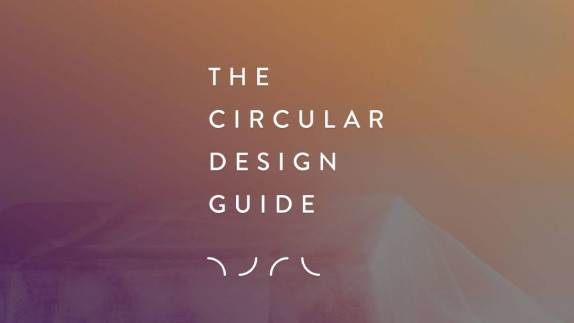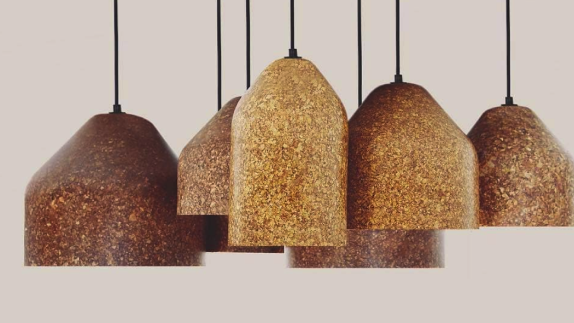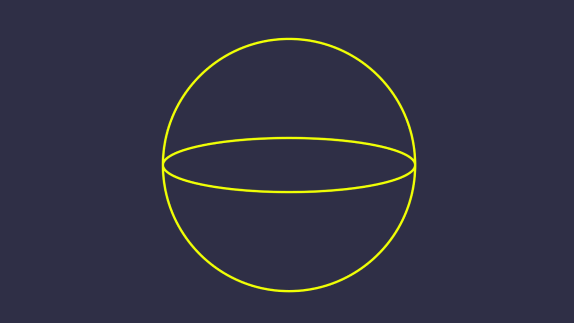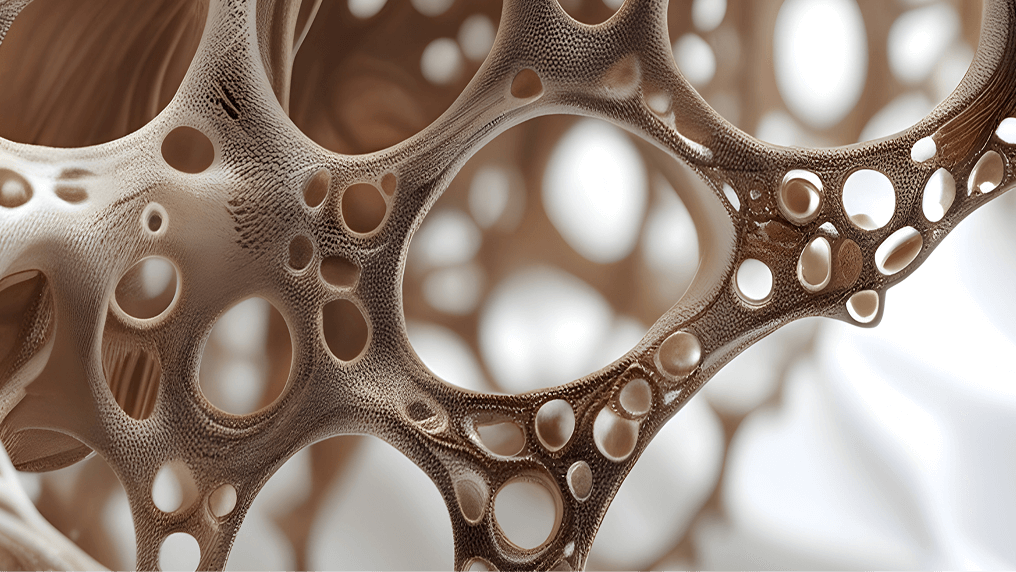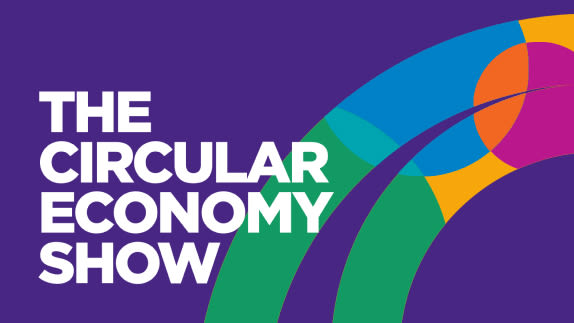Design decisions determine what we eat, what we wear, what we value, and how we communicate
The plastic takeout spoon that accompanied yesterday’s lunch was designed. The handle, curved in a way that makes it both ergonomic and stackable; the material choice, lightweight and cost-effective; the colour, immediately signalling the brand. Design is at the heart of every product and at the heart of the systems around it, from the supply chains needed to make it, to the business models that deliver it.
Design decisions determined where the plastic was sourced, the colouring agents used, and the machinery that pressed and formed the polymer sheets. They influenced how the spoons were individually wrapped, bagged, boxed, and sealed – and how they were shipped and delivered to retailers around the world.

Beyond the plastic spoon, design also influenced every other aspect of yesterday’s lunch: from ingredient selection, taste profiles, and production processes to the accompanying condiments and the packaging it all came in.
Besides its utilitarian and aesthetic functions, design powerfully shapes our desires, sparks our imaginations, and fuels our aspirations – influencing our purchasing behaviours through the use of seductive campaigns that feed our need for the new, the next, the better. Design shaped the very need for a takeout spoon in the first place.
Design shaped the very business models around the spoon, from the in-person order experience to the third-party delivery services, and the technology that made it all possible.
Throughout any product’s journey to market, many people – not only those who call themselves designers – impact how we design, make, and use the things around us. Architects, material scientists, business strategists, branding creatives, engineers, makers, and many others also influence design decisions.
Yet in our current linear ‘take-make-waste’ system, even the most carefully designed products are discarded, generally after just one short use. In some cases, items are deliberately designed to last as little time as possible, for reasons of hygiene, convenience or cost. However, such a system overlooks major challenges like resource scarcity, pollution, climate change, and biodiversity loss.
Today, the production of goods and food contribute to 45% of global greenhouse gas emissions. We have never produced more clothes nor worn them less: every second, the equivalent of a rubbish truckload of clothes is burnt or buried in landfill. Meanwhile, a third of all food produced goes to waste, while people suffer from hunger. It’s not just the materials that are wasted; the embedded energy, resources, and labour, and the social and cultural value of creativity are lost too.
Design in a linear economic model has been successful in providing affordable products on a mass scale. But the designed outputs of this extractive, wasteful, and polluting economy are also the underlying cause of climate change and biodiversity loss. In this material- and energy-intensive economic system, most of the goods bought for consumption are not returned for any further use, representing a huge economic loss which amounts to hundreds of billions of dollars. In addition, many people suffer from poor industry practices associated with extractive production: from exposure to hazardous substances or unsafe facilities to the lack of respect for their social and cultural rights.

An unprecedented momentum to move away from this linear system is already underway, and it requires a fundamental transformation of the way we make, use, and reuse products and food. While design has played – and continues to play – a critical role in building and sustaining these broken systems, it can also play a pivotal part in enabling better ones that work for the long term. This means radically rethinking design. Doing so requires willingness to change but also creativity, capacity, involvement from all sectors, a multiplicity of approaches, and the expertise of many. The challenge is urgent, but the future is hopeful.
Designers are already embarking on a more positive path
Motivated by this challenge, designers have begun to address the most salient feature of the linear economylinear economyAn economy in which finite resources are extracted to make products that are used - generally not to their full potential - and then thrown away ('take-make-waste').: waste. Tackling the most visible symptoms of this flawed system is readily actionable, and initially appears to be an effective first response, but in the long term, will never be ambitious enough, nor fast enough in the face of global challenges such as climate change and biodiversity loss.
What about using less?
Designing with material efficiency is critical, but alone isn’t sufficient. Extracting and wasting less can only buy us time and does not create a model which can work in the long term. For example, modern manufacturing processes can increase efficiency, but the gains are largely incremental. In the food system, progress can be made in productivity and food waste reduction, but the decline of soil fertility and land degradation are still unaddressed.
Additionally, without considering overall system effectiveness, design tweaks which prioritise efficiency can even have unintended detrimental effects. Consider the detergent bottles lining supermarket shelves. To minimise fossil fuel consumption, waste and production costs, a company could swap the packaging for a flexible film container – this uses half the plastic of the original bottle and is lighter to transport. Combined, these changes help to reduce CO2 emissions. But to only consider the material efficiency without considering what happens to the flexible packaging at its end-of-life overlooks the complete picture. The film, which is not widely recycled, will once again become waste. Rebound effects of design decisions can mean that what is gained on one hand, is lost on the other.
What about using waste as a resource?
Already, solutions which turn waste into resources and products, creating new revenue streams in the process, have emerged: upcycling textile sludge into bricks and recovered plastic bottles into trainer soles are some examples. However, collecting ‘waste’ to manufacture something new is often only the tip of the iceberg and it does not address the energy used and waste created to make the original product, or what will happen to this new creation when it’s no longer wanted or needed. Simply designing with waste, rather than designing out waste, tackles only part of the problem. Rather than designing a pair of trainers with ocean plastic, designing trainers to be more durable and repairable, and plastic bottles to be reusable, can ensure both stay in the economy. This isn’t about retaining them for just one extra cycle, but ensuring that they never become waste at all.
What about recycling?
Recycling brings real benefits: it reduces litter and pollution, and creates millions of jobs globally. But believing recycling will solve the world's environmental problems only lulls us into a false sense of security. With most recycling of materials such as paper and polyester, we lose quality. Across the fashion industry, less than 1% of materials used to produce clothing are recycled into new clothing, and as little as 12% are recycled into other products after use. Examples of such recycling include lower-value insulation and mattress-stuffing which are difficult to recapture at their end-of-life. Such actions simply result in a short delay to the products ultimately reaching the same linear fate.
Our leaky systems also mean that we lose quantity of material. An aluminium can – with a recycling rate of 90% and a useful product life of 3 months – would be entirely lost after 4 years. Perfect collection systems and sorting facilities don’t exist, even if they did, the inherent limitations of recycling leave us heavily dependent on extraction of new finite materialsfinite materialsMaterials that are non-renewable on timescales relevant to the economy, i.e. not geological timescales., and energy to refine them. Recycling alone will not ensure materials are kept in use and at their highest value in the long term.
Research shows that material efficiency and recycling play an important role in reducing raw material extraction, biodiversity loss, and CO2 emissions. However, they don’t tackle the root cause of waste and pollution, and require new inputs of energy, labour, creativity, and more each time.
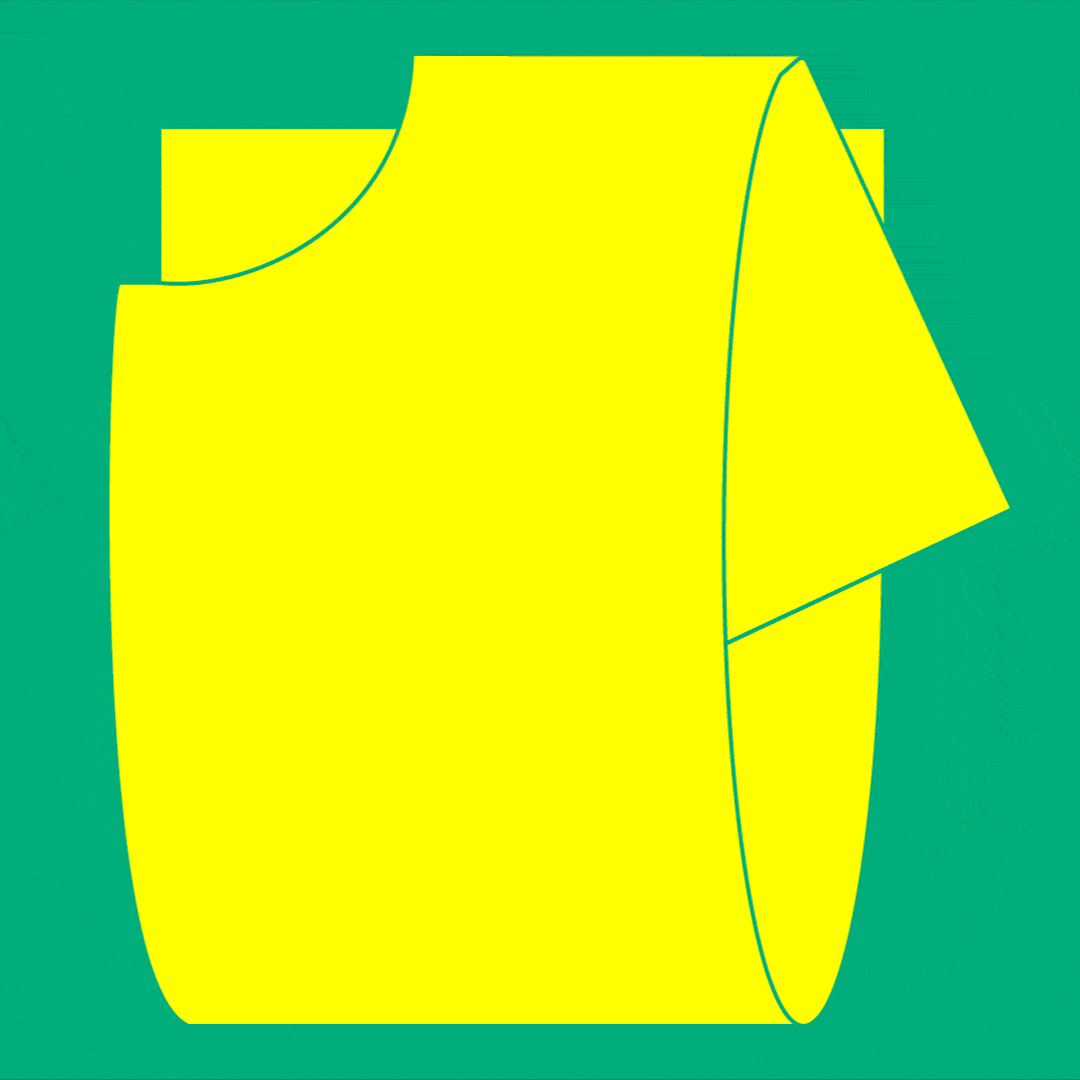
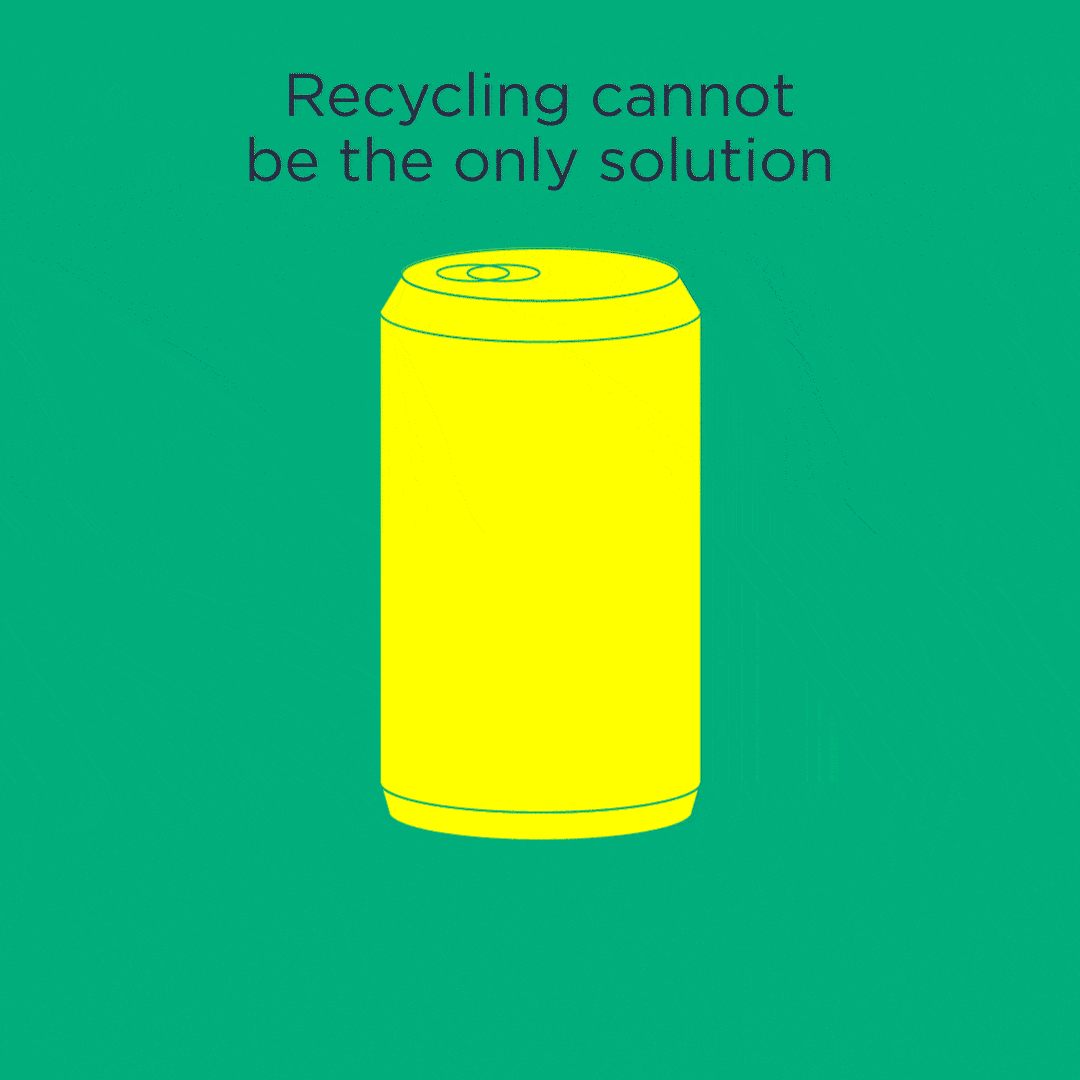
We need to go upstream, to create systemic interventions that design out waste and pollution.
The challenge ahead isn’t about treating the symptoms of an extractive economy. For designers, the innovation challenges lie upstream, before waste and pollution are even generated. We need to think about the opportunities for long-term value creation, rather than perpetuating an endlessly linear model.
Design has the power to be transformational, and those at the forefront of change are demonstrating this. Some are reinventing how we deliver everyday products, eliminating the need for plastic packaging on cosmetics and homecare by developing solid formulations and liquid concentrates with dissolvable membranes. Others are developing new service models that ensure household tools can be borrowed, electronics repaired, and clothing circulated. To spark the emergence of new systems, design interventions are required in every sector, from the way we make and use things, to the design of infrastructure and policies that enable products and materials to circulate in the economy.
The circular economy is driven by design
The circular economycircular economyA systems solution framework that tackles global challenges like climate change, biodiversity loss, waste, and pollution. It is based on three principles, driven by design: eliminate waste and pollution, circulate products and materials (at their highest value), and regenerate nature. is a systems solution framework that gradually decouples economic activity from resource consumption, and helps tackle global challenges like climate change, biodiversity loss, waste, and pollution. The circular economy offers opportunities for better growth that not only contribute to creating more resilient systems but also provide society-wide benefits such as a healthier environment. The circular economy also has the potential to reduce costs of accessing goods and services. Since 2012, the concept and economic rationale for the circular economy has been thoroughly researched and discussed, and is well documented in publications by the Ellen MacArthur Foundation as well as other business, policy, and academic research organisations. Today, momentum towards the transition is building in business and finance, with more and more companies adopting circular economy practices to create value and increase competitiveness.
Policymakers, at all tiers of government from cities to international institutions, are also turning to the circular economy as a critical economic development approach. Moving beyond downstream responses, such as better waste regulations, the circular economy is increasingly being recognised as an approach that supports policymaker priorities of harnessing innovation, providing a fresh approach to how we produce and consume, and addressing the interconnected challenges of waste and pollution, climate change, and biodiversity loss.
Together with finance and policy, design can help realise the ambitious vision of a regenerative, circular future.
Circular design applies and enables the three principles of the circular economy: Eliminate, Circulate, Regenerate. Whether we’re (re)designing a product, service or business model, circular design uses systems thinking to create solutions that deliver better outcomes for the entire system.
In practice this means:
Eliminate waste and pollution upstream through design
Consider choosing safe materials designed for repeat circulation, making use of by-products, or engaging in material and product innovation
Circulate materials and products by designing them to be kept in use, and at their highest value, for as long as possible
Consider designing for repairabilityrepairabilityThe ease with which a product or component can be repaired., upgradability and emotional durabilitydurabilityThe ability of a product, component or material to remain functional and relevant when used as intended., as well as creating the reuse, repair, remanufacture, and recycling systems and business models (resale, rental, sharingsharingThe use of a product by multiple users. It is a practice that retains the highest value of a product by extending its use period.) that allow products and materials to be used more times, by more people, and for longer
Regenerate nature by designing to improve local biodiversity, air, and water quality
Consider designing for regenerative outcomes, i.e. creating the conditions for nature to thrive
Consider designing for successive cycles in which bio-based materials are used through different applications and are safely returned to the earth
Applying the three principles of a circular economy within a systems thinking approach provides a sense of direction for us to better navigate the complexity of systems change. The consequences of interventions designed to shift the system may not always be foreseeable. Using systems thinking to inform circular design therefore helps us to contextualise problems, identify opportunities for systems change, and create the capacity for learning as new information and technology become available.
Systems thinking isn’t an individual exercise, but a collective one. It leans on the interdisciplinary expertise of actors across the value chain, and the experiences of those people invested in – and affected by – systems change.
Circular design involves oscillating from the broad vision and principles of a circular future to the creation and testing of interventions which deliver immediate positive impact and are increasingly circular over time. It is a creative, collaborative endeavour for designers in the broadest possible sense, with the aim of contributing to the plurality of solutions needed to shift economic systems at scale.
It starts with a critique of how some of the things that we’ve valued about design — it being user-centred, agile and iterative, and problem-solving — are no longer adequate if we want to transition to a different world. Instead, we need to act more collectively or planet-centred, be bold and transformative, and see ourselves as stewards of continually changing situations.” Cat Drew, Chief Design Officer, Design Council
Circular design has been influenced by, and builds upon, an expansive body of research and practice, including Systems Thinking, Systemic Design, Cradle to Cradle, Transition Design, Biomimicry, Regenerative Design, and others. These concepts reveal different facets of the economy-wide shift from linear to circular, and together represent a powerful, pervasive design movement.
How to get started: applying circular design
Complex and systemic design challenges can be tricky to navigate and are ever-evolving. Here are three interrelated actions that can help designers to apply circular design:
Zooming in and zooming out: designing within a context
Widening the scope of value creation
Evolving with continuous feedback
Zooming in and zooming out: designing within a context
In circular design we can zoom in and out to three different but interconnected system lenses:
Individual <> Society
Local environment <> Global ecosystems
Singular value exchange <> Economic systems
Consider the bigger picture. The act of zooming in and zooming out through different lenses helps to develop a greater contextual awareness of the system we’re designing within and for. It can uncover the root cause(s) of a problem and is a way to continually evaluate the existing and future impacts of design decisions, both positive and negative.
In a linear economy, design typically happens in isolation, zooming in only to the short-term needs of the business and customer, while externalising the wider social, environmental, and economic impacts. In a circular economy, design decisions take into account the system as a whole over a longer period of time.
Connect the Dots, São Paulo
Zooming in and zooming out
One example of zooming in and zooming out to create circular food systems is Connect the Dots. This collaborative project provides nutritious food to inhabitants of São Paulo, while supporting regenerative farming systems in surrounding areas, and helping tackle social inequality.
Zooming in, farming families with smallholdings on the fringes of the municipality face multiple socio-economic challenges, such as increasing ecosystem degradation from growing urbanisation and loss of income opportunities. Zooming out spatially and socially, there are also large vulnerable populations in the city centre with poor access to healthy and nutritious food. Meanwhile, drought is increasingly threatening the water networks upon which the city of São Paulo relies.
In response to these systemic challenges the municipality of São Paulo is working with actors across the food value chain to implement actions at multiple system levels. Initially focusing on the supply of seasonal, high-quality food for schools and public canteens, the initiative committed to procure organically and regeneratively produced food directly from local farmers at a price 30% more expensive than market value to incentivise the transition. Meals are designed to use local, seasonal produce and any food that can’t be used is then composted in the city and returned to farmers to fertilise the soil.
Beyond public procurement, the project includes initiatives to create a distributed and resilient business model connecting farmers to a wide array of buyers in the city centre, including street food markets, restaurants, and food delivery companies. Farmers transitioning from conventional agriculture to practices with regenerative outcomes are given access to education and technical assistance. Support is also provided through improved road infrastructure, access to warehouses, and financial incentives. There are also engagement and learning programmes for city schools and chefs. Connect the Dots is a long-term, place-based programme of systemic initiatives generating a multitude of societal, environmental, and economic benefits. Take a look at the system map of the region’s local agricultural value chain.
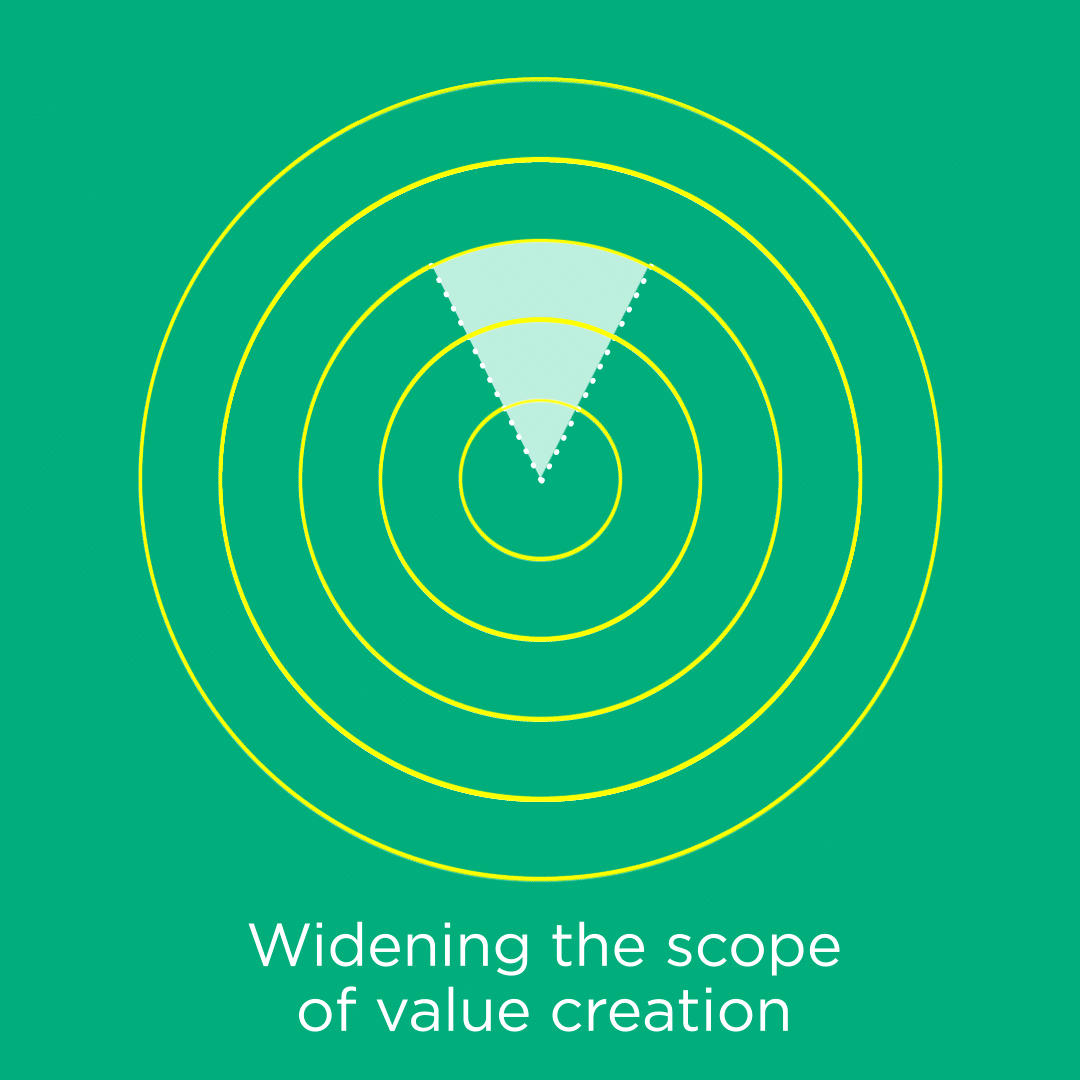
Widening the scope of value creation
By widening the scope of what we’re designing for beyond economic profit alone, we can create new kinds of value creation opportunities not possible with the narrow scope of a linear economy. Circular design is about designing interventions at different levels of the system: the product, the business model around it, and the system conditions – i.e policy, finance, and education –that enable that model to thrive. In so doing, we shape an ecosystem in which value is distributed.
It is about unlocking value at every stage of the process by maintaining the materials already in use, increasing the number of users for every product, and using practices that have regenerative outcomes for nature.
To illustrate value creation opportunities within a healthy system, nature is perhaps the ultimate example. In a forest, the leaf that falls from the tree feeds the earth, wild animals disperse seeds and enrich soils, and fungal ‘neural’ networks redistributeredistributeDivert a product from its intended market to another customer so it is used at high value instead of becoming waste. nutrients. Not only do the plants, wildlife, fungi, and bacteria coexist, they benefit each other. Observing these properties of natural systems can inspire the creation of resilient and regenerative business ecosystems.
Connect the Dots, São Paulo
Widening the scope of value creation
For the city of São Paulo, implementing an isolated financial mechanism would have provided a solution to local growers, but it would have been short-term. Instead, the municipality identified opportunities for value creation across the entire food system that will create benefits in the long term. By widening the scope of design, the municipality is addressing overlapping social and environmental challenges in both inner city and peri-urban areas. The food regeneratively produced on the fringes of São Paulo generates profit for the farmers, local communities, and city centre businesses alike. These practices bring together a range of benefits such as creating employment opportunities for the next generation of farmers at the same time as improving soil health, helping to halt and reverse biodiversity loss, and preserving freshwater. The regeneratively produced organic food brings long-term health benefits and fosters a system that creates equitable access to nutrition for vulnerable populations. Its educational programmes help to deepen knowledge and skills in regenerative farming systems. Collectively, the additional infrastructure to support the project not only helps to strengthen the food system, but also allows people in rural areas to move around more easily, bridging ecology and economy.
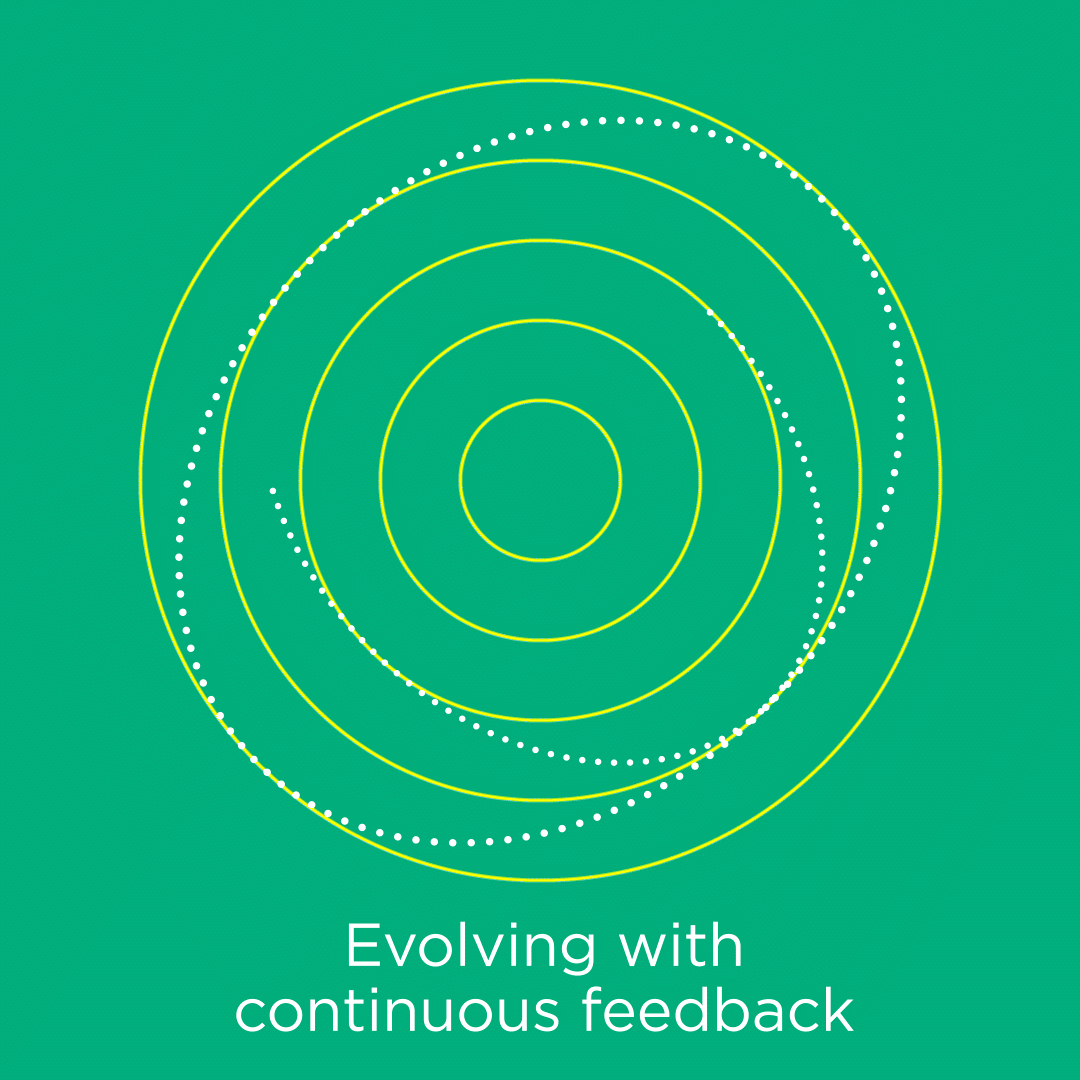
Evolving with continuous feedback
Since circular design reveals the complexity of the world around us, finding the ‘right’ place to start can be overwhelming. It’s important to start somewhere and evolve over time, as there won’t ever be a complete data set or checklist to hand. Designing interventions that shift the system for a better future is not an exact science. The economic systems we are designing in have emergent properties; much like weather systems, they accumulate complexity and constantly evolve. There are many unknowns. Furthermore, we are designing in a time of transition in which both the linear economy and the circular economy coexist, so we may find tension between the incentives, structures, and behaviours of the old model and those of the new.
One of the most important skills is being able to toggle between the micro view or your own area of expertise and specialty, and big picture, and understanding both spatially and orally – how what you're doing at any given time, can contribute to the whole, and the need for that whole to be transitioning toward a future that’s sustainable, equitable, and desirable.” Terry Irwin, Director, Transition Design Institute
Whether designing products, services, and the systems that surround them, or the processes and policies that support them, embedding mechanisms to create feedback loops can help follow, measure, and evaluate the system response over time. This could range from simple user interviews to integrating digital ledgers.
This evaluation of system feedback can help designers improve solutions and uncover new opportunities to create and scale system-wide value.
Connect the Dots, São Paulo
Evolving with continuous feedback
Connect the Dots project demonstrates that there is still agricultural and food waste across the system that needs to be addressed. These initial pilots, while vitally important, are not yet mainstream and need to scale across the region. By demonstrating a circular food system in action it can also inform how other cities, municipalities, and local governments could approach similar systemic challenges.
Developing the right enabling environment and creating the necessary tools to support the change is critical. In this case, the Connect the Dots project led to the collaboration with Sampa + Rural and Sis Sampra to build a digital platform to help farmers access technical assistance, training, equipment, and finance. The tool is also vital in enabling the collection and analysis of real-time information on rural production and monitoring action plans. Through this continuous feedback, the design of actions, policies, programmes, and infrastructure can evolve to the needs of the wider system as the pilot grows.
Circular design is how we fundamentally reimagine our current system for positive outcomes in the long term, and it starts today.
Actions to nudge systems can be as small as so that they can be made to be made again in the future. Or action could also be taken at an organisational level, such as developing circular design metrics to equip designers with the right tools. Wherever the starting point, consider the wider implications of interventions in place and through time.
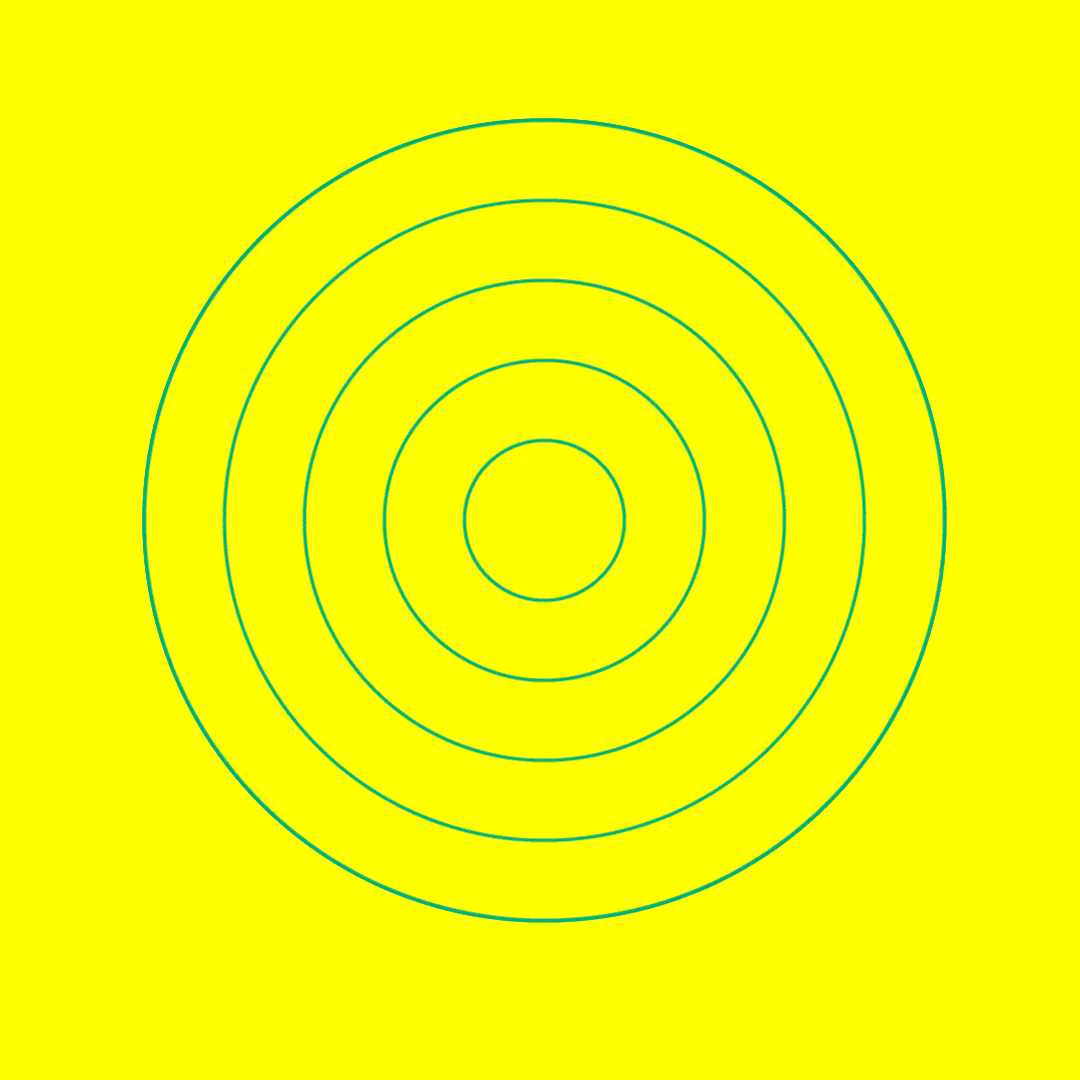
We all have a part to play in designing better systems that work in the long term.
For more resources and activities to help understand, define, make, and release circular innovations, explore the Circular Design Guide created in collaboration with IDEO and a selection of tools from our network and beyond to help get you started.
